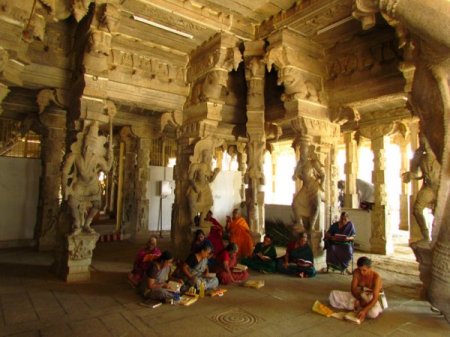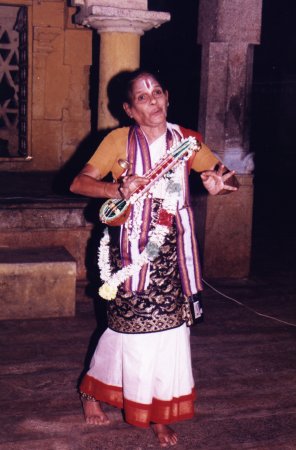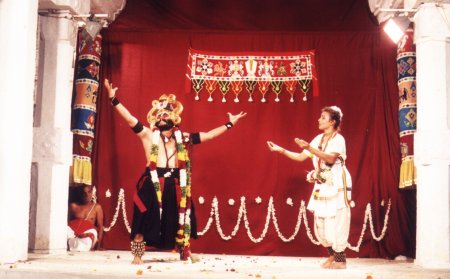
|
 |

|
 |
RECONSTRUCTING AND REVIVING AN ANCIENT TEMPLE THEATRE RITUAL - Lalitha Venkat e-mail: lalvenkat@yahoo.com Dec 2001  (Lalitha Venkat speaks to Professor Ramanujam at Thirukurungudi) Professor Ramanujam is a well-known Tamil theater director, a writer, a translator and a keen revivalist. He has worked on reinterpreting classics from Greek and Latin plays and rewriting many famous Greek tragedies for Tamil theater audiences. He has been involved as professor at Thanjavur University and has also been a director of several Tamil plays. He has been associated with Na Muthuswamy of Koothu-P-Pattarai for over 20 years and travels extensively within Tamilnadu as consultant and as a lecturer about theater. For the last 5 years, Prof. Ramanujam has been involved in the revival and reconstruction of the 13th century theatre ritual of Kaisika Natakam in the temple of Thirukurungudi in Tirunelveli district in Tamilnadu. This is a project supported by Arangham Trust and it has involved his working with artistes, musicians and scholars, writers and members of the traditional arts community associated with temples. The first revival performance after a gap of 50 years was staged in 1998 on the day of Kaisika Ekadasi and since then it has become an annual all night drama ritual in the temple town of Thirukurungudi.  How did you come to know about Kaisika Natakam? By accident. I belong to Nanguneri. It's very near to Thirukurungudi which is my mother's native place. Since my childhood was spent in South Travancore, I had less touch with my native village and was not aware of Kaisika Natakam in my younger days. After a long time in my life, when I became professor in the University of Thanjavur in the Dept. of Drama, I used to study the structure of old traditional theatre forms in order to know better about theatre and drama. And I did research on a project also as part of my dept. work. Fortunately, I happened to meet one of my aunts who at that time was nearly 92 years old - she died at the age of 99. I casually asked my aunt about any traditional theatre forms in the temples nearby. She told me then about the one in Thirukurungudi. I had a tape recorder with me and my inner sense told me to record all that she had to say. I still have it with me. She told me the details of Kaisika Natakam, which was performed here about 2 or 3 days after my discussions with her. It was very timely and kindled my interest in this form. Which year was that? Maybe '92 or '93. I'm not sure. After I saw the form, I videotaped some talk with some of the artistes here. I showed this to one of my friends in Thanjavur. He gave me a manual by an American who had already done research on it, Mr. Wellburn. That gave me full details including translation of not this Nataka, or the drama, but the translated version of the Kaisika Purana. There are two things. One is Kaisika Purana is in Sanskrit and it is translated into Manipravala Tamil, the Sanskritised Tamil that is read in a remote corner of the Vaishnava temple. He had translated that version. It had details of the drama and my interest increased. Why did you think it needed revival? What motivated you to revive it? The thing is, even now I cannot say we are reviving it. Revival is only a kind of first stage. When I first saw the drama, it was very difficult to revive it from that form. If we find a form, which is in a weak position, we can think of a revival. The condition is different here. There was almost nothing to start with. There was no theatre form, only some words in the name of dialogues were spoken on stage. So, the issue here is more of reconstruction than revival. Of course, the credit of the revival goes to Anita (Ratnam) than me. She had taken the challenge to look into the matter. Both of us had to reconstruct it, rather than revive it. How did she get involved in the project? That also happened purely by chance. I had told Mr. Muthuswamy (of Koothu - P - Pattarai), a fellow theatre person, about this form and he told Anita about it. So, Anita wanted to meet me. The three of us met at her house and I told her about this theatre form at her native place. She asked me about what we can do, whether the problem was the revival or the reconstruction of the form. At that time, I was not in a position to give a concrete answer. We decided to work on what we had on hand and check on the video recording of the present form and I asked for time to think over what was to be done. It took me nearly 6-7 months to come to a decision to reconstruct it. You asked me what made me interested. As a theatre person, working with the so-called modern theatre, we used to take so many elements from the traditional. But here, the challenge was what is a modern theatre worker going to offer tradition? And I took up the challenge. What were the difficulties you faced in the process? Firstly, the artistes were beyond their capacity to recall anything from their subconscious mind, about the details of the theatre. Of the present artistes, two are important and are from the Devadasi families. They are quite old. The present artistes are not the direct descendants of the Devadasi system of Thirukurungudi. They are from some other village and their contact with Thirkurungudi village is rather less. So, the question was, who was to tell me about the basic theatre? I interviewed a cross section. An old lady came there and I asked if she had seen the dance, what sort of songs, what elements. Generally, everybody told me about the story, but nobody could tell me about the performance aspect. To know about the exact performance, the next difficulty was the script. One of the men who's part of the tradition, has the responsibility of continuing the tradition and he's here now and he takes part too. He has a very good handwritten script with him, but he never revealed anything to me. I could not get any relevant information from the artistes. So Anita and I tried to give them some incentives like monthly stipend, but that didn't work. They refused to reveal anything or..? It's not like that. I cannot really blame them. They were ready to cooperate but for a long time, the tradition has been lost in the temple, so it was beyond their limit to recall anything of the past. That was the basic problem. They're very modest people. They never refused or resented anything. It's just that they cannot recollect completely? They cannot recollect at all! How did you go about reconstructing the script, the music..? The first important thing is the script. Fortunately, because of my frequent visits to Thirukurungudi and working with the artistes, I had a lot of interaction with Thirunarayana Iyengar who's a great scholar and a person who knows about everything. His confidence in me grew and he slowly revealed the existence of a palm leaf manuscript in his possession. I was finally able to win his total confidence in me and get the manuscript. I promised to do my best and the Kaisika Natakam is based on that promise. When I got the palm leaf manuscript, I immediately had everything translated, a copy was made and the palm leaves were returned to him. So, the script got ready. The palm leaves are in the temple? No, they are even now in the Mutt. How did you go about the selection of the artistes and the music, which you recorded recently? The question is, there were so many songs in the script, but not even a musical sound was rendered in the previous performance. There were no recitations of poems either. In one of the verses in this script itself, there is a mention of so many ragas. And the people said it was sung, so the music must be rediscovered. That was important. But in a reconstruction process, any attempt at rediscovery will evolve in a new construction. That's what happened here. I wanted to find a proper person. I struggled for two years in Tirunelveli to find a dancer or singer to help me. I visited so many places. I also visited ladies in the agraharas to see if they could sing something. That was a sort of incubation period. During that time, I was able to meet Anita too.  I made a decision that it could be done only with artistes of Thanjavur since they were already acquainted with some kind of temple drama that was enacted in Thanjavur, Sarabendraboopala Kuravanji. The old lady Doraikannu has danced in that performance long ago, in the '40s or '50s. So I thought Herambanathan's contribution could be big in the reconstruction. He cooperated with me and has done his maximum best. Even though there is some kind of limitation, he put together the classical artistes with their illusions. He was able to grasp the idea and I felt it should be done with the Thanjavur artistes. He accepted the idea and we began work. I had a number of interviews with the Vaishnava scholars and people who know the Kaisika Purana and arayer artistes. I have the tapes, the transcriptions too. That helped me a lot to a deeper understanding of the script. Who actually gave the music input? Actually, even now, the reconstruction is in its process. Herambanathan did the first part with the help of Ramadass who used to sing in the Bhagavathamela tradition at Saliamangalam. Together, they formed a kind of music for this. I know it's not easy. They belong to the Bhagavathamela tradition. I knew from my experience that our traditional people are very talented, but as far as creativity is concerned, they can create only manipulations than create innovations. So they began to manipulate already known ragas that existed in one theatre form and began to use it for this theatre form. In a way, it's like imposing one theatre form that is the Bhagavathamela, into the Kaisika Natakam. But as a beginning in the process, I accepted that. In its present form, how much more is needed for you to mould the music to your satisfaction? I've not completed the music process there. I collected many artistes who belonged to different sections--musicians, theatre artistes--from Thanjavur and we had a good discussion after the first revival performance. They gave me some ideas and I had to admit that I didn't want to retrain the Bhagavathamela element. So, we planned again. Fortunately, Vaithyalingam, a musicologist, well versed in Tamil music, helped me a lot, Velusamy in the verses. Along with Padmanabhan, Herambanathan and Anita, I met them all for a discussion in Madras and based on the previous music, we evolved fresh music for the Natakam. I'm happy to say we have arrived at very good music and you must hear the voice of this traditional musician who used to sing another form, not Bhagavathamela, but it gives me a feeling that I'm hearing an old music tradition. Who is this musician? He's Srinivasan and you will hear him sing today.  How important is the revival of the Kaisika Natakam to the performing arts? I have to look at it from 3 or 4 angles. Basically, I'm a theatre person. On seeing the script, first of all, the theme struck me a lot, especially when we look at it from a contemporary angle, about the issue of caste and creed. It's a most revolutionary theme that a low caste fellow is giving moksha (salvation) to a high caste Brahmin. The nature of performance has also given me a new sociological interaction in the society. I'm able to see that devadasi artistes are allowed very close to the utsavavigraha. You will see that this evening. Thirdly, the artistes who are supposedly of a lower caste than Brahmins are given an elevated platform to perform on and the higher caste people squat on the ground at a lower level to watch. That is another phenomena, the second sociological phenomena. We have discussed the theatre artistes, the theme and construction of the play. Fourthly, it gives a good idea of a ritualistic theatre; we have to make people see how theatre is different from an exhibition. To make it a ritualistic experience, theatre has so many sequences and I'm trying to make it more ritual rich. These factors motivate me greatly. I think that answers your question. What are the other projects that you are involved in? I'm basically a children's' theatre person. Every year, I used to produce two children's' plays and I love to interact with children. These plays are in Tamil? Both in Tamil and Malayalam. My services are more recognized in Kerala than in Tamilnadu! That's a fact. Even in children's' theatre, my idea is not to merely produce plays for the platforms. It's to create a dramatic situation of a play to motivate the children who participate to share their dramatic experience and theatre experience. It's not something merely happening on stage. Children have a tendency to dramatize everything. It should be made into a collective expression. Also, as a person involved in theatre forms in a period, which needs so many things, we had to introduce new theatre forms, new ideas; we had to take the people into the precincts of present theatre. I've been involved in many research projects of that nature. Now I'm thinking of another important project where I'm going to work on this kind of thing after getting some breathing time from this Kaisiki project. I want to know the cross-cultural construction in Thanjavur theatre. There were so many cultural interactions-Telugu people, Marathi people, Muslim people and so many have ruled Thanjavur in the past. There are around 8 or 9 forms in Thanjavur. So I want to study the cultural interactions. That's my other different project! Do you have any plans for future development of Kaisiki? A very good question. I cannot state an ambition. We want to take the proper efforts to make it have long standing results; otherwise all the present efforts will vanish, if there's no continuity. We're trying to create a tradition that will go on for hundreds of years. Otherwise there's no meaning to reviving this tradition. So, that's a major problem we're facing. So far, Thanjavur artistes are working on this, including some young girls. Suppose someone gets married and wants to quit, we have to replace that person. For how long can a person from Thanjavur do a theatre form in Thirukurungudi? That's a problem. We're not reconstructing a play. I want to make one thing clear. Kaisika Natakam is the full name, not Kaisiki. Kaisiki is the name I had given my project alone. The other problem is, it's not making a performance, directing one play. It's in building a form that should go down from generation to generation. That's the basic task of Kaisika Natakam reconstruction. Not reconstructing a play, but reconstructing a tradition… Yes. You've put it right. It's reconstructing a tradition in a theatre form. For this, a theatre form needs good training, good artistes, good scope for performance output. One idea Anita and I spoke of yesterday. If possible, we want to try out this form in other temples. 3 or 4 performances on different Ekadasis in the year and culminate in Kaisika Ekadesi at Thirukurungudi. It's a very good plan. Another plan is, I'm asking the traditional people to try to find people from their side, otherwise we have to locate different people, give them basic training in Bharatanatyam, basic training in singing and dialogue rendering, to create a new kind of artiste suitable to the Kaisikam, train them in Kaisikam, hand over the Kaisikam to them, so the tradition will continue, maybe one or two groups, maybe even three, and from them another generation can be created. The story enacted in the Kaisika Natakam Post your comments Please provide your name and email id when you use the Anonymous profile in the blog to post a comment. All appropriate comments posted with name and email id in the blog will also be featured in the site. |